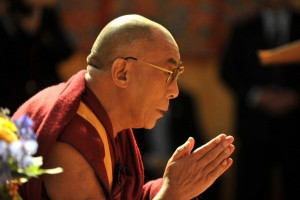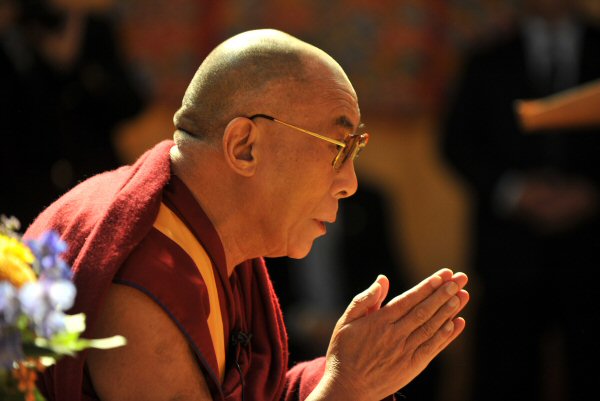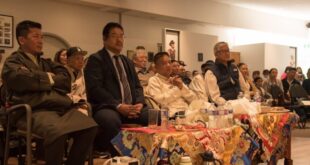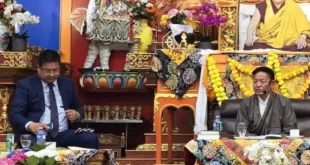On 29th November 1956, on the occasion of the 2500th anniversary of the Buddha’s Parinirvana, I had the opportunity to meet Indian leaders and Buddhist representatives from many countries here inNew Delhi. At that time I gave a detailed account of the historical development of Buddhism inTibetand the unique Indo-Tibetan relationship. Since then the world, includingIndiaandTibet, has witnessed many changes and so have the Buddhist traditions in different countries.
Until the last fifty years or so, the world’s diverse Buddhist communities had only a distant inkling of each other’s existence and little appreciation of how much they held in common. As the Buddha’s teaching took root in different places, certain variations in the style in which it was practised and upheld evolved naturally. Indeed, the Buddha himself gave different teachings according to the predispositions of his disciples at different times. What distinguishes our contemporary situation is that almost the entire array of Buddhist traditions that evolved in different lands is now accessible to anyone who is interested. What’s more, those of us who study and practise these various Buddhist traditions can now meet and learn from one another.
Shakyamuni Buddha attained enlightenment in Bodhgaya about 2600 years ago, yet I believe his teachings remain refreshing and relevant today. Moved by a spontaneous concern to help others, following his enlightenment the Buddha spent the rest of his life as a homeless monk, sharing his experience with those who wished to listen. Both his view of dependent arising and his advice not to harm anyone, but to help whoever you can, emphasize the practice of non-violence. This remains one of the most potent forces for good in the world today, for non-violence is to be of service to our fellow beings.
Siddhartha’s renunciation – his choosing to live the homeless life – symbolises the practice of the training in morality; his six-year asceticism symbolises the training in concentration; and his attainment of enlightenment through the practice of wisdom under the Bodhi tree represents the importance of the cultivation of wisdom. The role of these threefold trainings in the Buddha’s life highlights their importance in our daily practice. To be able to carry out these practices, we have to study the Buddha’s teachings contained in the Tripitaka.

In an increasingly interdependent world our own welfare and happiness depend on many other people. Other human beings have a right to peace and happiness that is equal to our own; therefore we have a responsibility to help those in need. Today, in a new millennium, our world requires us to accept the oneness of humanity. Many of our world’s problems and conflicts arise because we have lost sight of the basic humanity that binds us all together as a human family. We forget that despite the superficial differences between us, people are equal in their basic wish for peace and happiness. Part of Buddhist practice involves training our minds through meditation. But if our training in calming our minds, developing qualities like love, compassion, generosity and patience, is to be effective, we must put them into practice in our day-to-day life. Even as our world continues to develop materially, there is increasing need for similar progress in our sense of inner values. The 20th century was a century of war and violence; now we all need to work to see that the 21st is a century of peace and dialogue. We Buddhists can contribute to this by learning from the world’s other religious traditions and sharing with them the distinctive qualities of our own tradition.
There is great emphasis on the practice of love and compassion in the Buddha’s teaching, as in the teachings of other spiritual traditions, but it is important to recognise that compassion and love are fundamental to relations between sentient beings in general and human beings in particular. I believe that we should no longer talk about Buddhist ethics, Hindu, Christian or Muslim ethics, because these values are universal. Buddhism does not explain the virtue of values such as honesty and integrity in a way that is different from how Christianity or Islam or any other religious tradition explains them. Therefore, in recent years, I have found it more appropriate to talk about the need to foster what I call secular ethics. I refer to these values as secular ethics because believing in one religion or another or not believing in one at all does not affect our need for them. The basic foundation of humanity is compassion and love. This is why, if even a few individuals simply try to create mental peace and happiness within themselves and act responsibly and kind-heartedly towards others, they will have a positive influence in their community.I believe Buddhism does have a special role to play in our modern world. This is because, unlike other religious traditions, Buddhism uniquely propounds the concept of interdependence, which accords closely with fundamental notions of modern science. We can think of Buddhism in terms of three main categories – philosophy, science and religion. The religious part involves principles and practices that are of concern to Buddhists alone, but the Buddhist philosophy of interdependence as well as the Buddhist science of mind and human emotions are of great benefit to everyone. As we know, modern science has developed a highly sophisticated understanding of the physical world, including the subtle workings of the body and the brain. Buddhist science on the other hand, has devoted itself to developing a detailed, first-person understanding of many aspects of the mind and emotions, areas still relatively new to modern science. Each therefore has crucial knowledge with which to complement the other. I believe that a synthesis of these two approaches has great potential to lead to discoveries that will enrich our physical, emotional and social well-being.
Although Buddhist contemplative tradition and modern science have evolved from different historical, intellectual and cultural roots, I believe that at heart they share significant interests in common, especially in their basic philosophical outlook and methodology. On the philosophical level, both Buddhism and modern science share the same view on the absence of absolutes, whether described as a transcendent being, as an eternal, unchanging entity, or as a fundamental substratum of reality. Both Buddhism and science prefer to account for the evolution and emergence of the cosmos and life in terms of the complex interrelations of the natural laws of cause and effect. From the methodological perspective, both traditions emphasize the role of empiricism.
For example, in the Buddhist investigative tradition, among the three recognized sources of knowledge – experience, reason and testimony – it is the evidence of the experience that takes precedence, with reason coming second and testimony last. This means that in the Buddhist investigation of reality, at least in principle, empirical evidence should triumph over scriptural authority, no matter how deeply venerated a scripture may be. Even in the case of knowledge derived through reason or inference, its validity must derive ultimately from some observed facts of experience.
The primary motive underlying the Buddhist investigation of reality is the quest to overcome suffering and perfect the human condition; therefore the Buddhist investigative tradition has been primarily directed towards understanding the human mind and its various functions. Our aim in seeking ways of transforming our thoughts, emotions and their underlying propensities is to find a more wholesome and fulfilling way of living. So a genuine exchange between the cumulative knowledge and experience of Buddhism and modern science can be deeply interesting and potentially beneficial as well.
In my own experience, I have felt deeply enriched by engaging in conversations with neuroscientists and psychologists on such questions as the nature and role of positive and negative emotions, attention, imagery, as well the plasticity of the brain. I am grateful to the numerous eminent scientists with whom I have had the privilege of engaging in dialogues that have continued over the years through the auspices of the Mind and Life Institute, which initiated annual conferences that began in 1987 at my residence inDharamsala,India.
Of course, most people feel their own form of religious practice is the best. I myself feel that Buddhism is best for me. But this does not mean that Buddhism is best for everyone. What is important is what is suitable for a particular person or group of people. Religion, for most of us, depends on our family background and where we were born and grew up. I think it is usually better not to change that. However, the more we understand each other’s ways, the more we can learn from each other.
By declaring my respect for all religious faiths, I do not advocate attempting to unify our various traditions. I firmly believe we need different religious traditions to meet the needs and mental dispositions of the great variety of human beings. All the major religious traditions make the betterment of humanity their main concern and all of them carry a similar message. When we view them as essential instruments for developing good human qualities such as compassion, tolerance, forgiveness and self-discipline, we can appreciate what they have in common.
I am convinced that the most significant obstacle to inter-religious harmony is the lack of contact between different faith communities and consequently, the lack of appreciation of their mutual value. However, in today’s increasingly complex and interdependent world, we have to acknowledge the existence of other cultures, different ethnic groups, and, of course, other religious faiths. Whether we like it or not, most of us now experience this diversity on a daily basis.
Even amongst the various Buddhist traditions that have come about in different times and places, there are those who look to the collection of scriptures preserved in Pali as their source and those who look to the Sanskrit tradition. I believe that time has now come to communicate freely with one another, those in the Pali tradition engaging in dialogue with those in the Sanskrit tradition. After all, all our different branches come from the same common trunk and roots. As a Tibetan Buddhist monk, even today I consider myself a student of the Nalanda tradition. The way Buddhism was taught and studied at Nalanda University represents the zenith of its development in India. If we are to be 21st century Buddhists it is important that we engage in the study and analysis of the Buddha’s teachings, as so many did then, instead of simply relying on faith.
Therefore, the study and practice of the Buddha’s teachings is necessary to preserve and promote them. The Sangha played a pivotal role in this during the Buddha’s time, and I am happy that the tradition continues to this day. Consequently, it is important for members of the monastic community to abide by their vows to sustain the purity of the Buddha Dharma.
In the past, given the nature of the different backgrounds under which the Buddha Dharma flourished in our different societies, there have not been many opportunities for Buddhists to come together and to discuss issues of common concern. This congregation has provided a much needed crucial opportunity. Now and in the future we need to encourage and foster an exchange of knowledge and experience among our different traditions and improve communications amongst us. I hope this will be the first of many such occasions that will enable us to foster better understanding and contribute more effectively to human happiness and peace of mind throughout the world. On the occasion of the 2600th anniversary of the Buddha’s attainment of enlightenment in Bodhgaya, I offer my greetings to this eminent Global Buddhist Congregation.
25 November 2011




